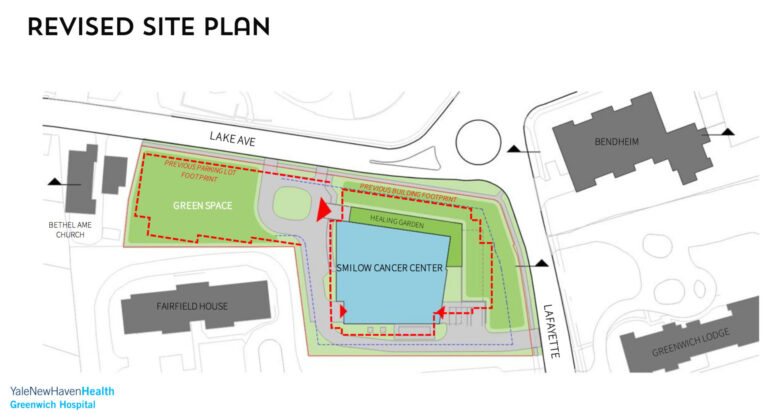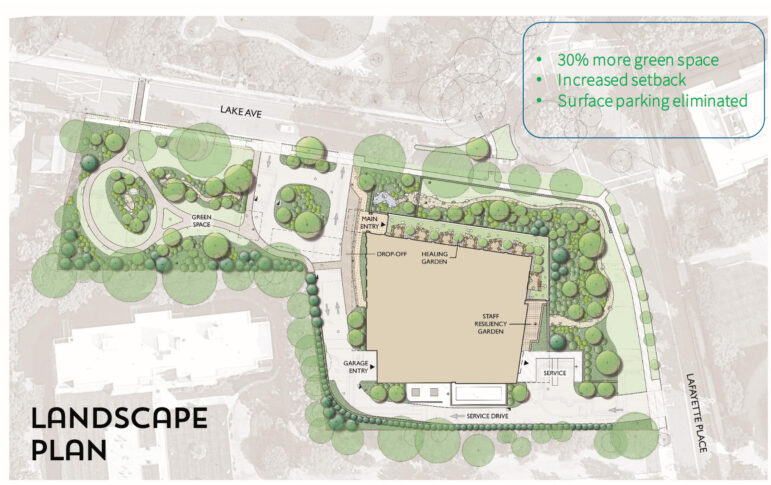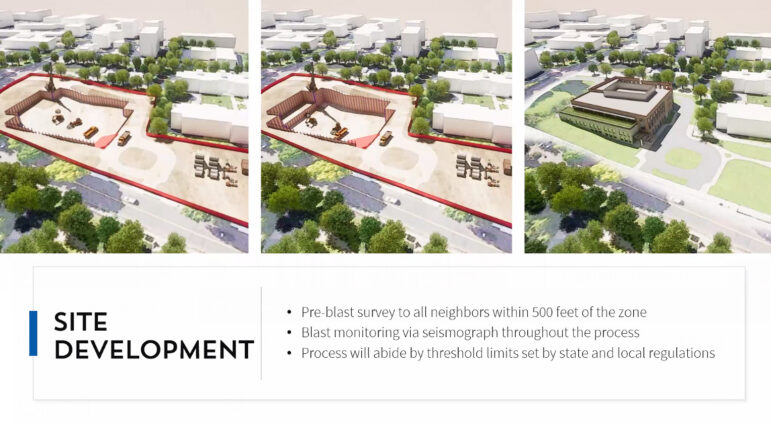Greenwich Hospital’s new pre-application for a new Smilow Cancer Center on Lake Ave and Lafayette Place went before Planning & Zoning last week.
Since the application was denied last summer, the hospital started over and, with changes, the proposed facility is now lower in height and smaller in footprint. All parking is underground. The power lines will be buried. The loading area will be screened. And there is more green space overall.
Hospital president Diane Kelly said the hospital had explored three other locations, but she said co-locating the cancer center by Greenwich Hospital was essential, in part because of the technology and equipment required, but also in order to provide integrated care.
“This smaller building now in a sense is sitting in its own park.”
– P&Z Commissioner Nick Macri
“Cutting edge cancer care is not just Oncologists, but a team of doctors in surgery, medical oncology, radiation therapy, imaging and pathology, who are collaborating together in one place, all centered around the needs of one patient,” she said.
She said many of the changes in the application were in direct response to feedback from neighbors after meetings with the community.
P&Z chair Margarita Alban suggested the hospital share some of the lessons learned from the other 13 Smilow locations in the Yale New Haven Health System. She noted some are and some are not in residential neighborhoods.
Architect Luke Voiland elaborated on some of the site plan changes. The building has been pulled back from Lafayette and concentrated it toward the center of the site. Green space has been increased 30%.


Chris Enders from Gilbane Building Company said his firm had recently worked on the new New Lebanon School in Byram, and the addition to Greenwich Library.
He said quite a bit of rock will need to be removed to create underground parking for Smilow. They plan to use controlled blasts.
“We assure you that we are committed to being good neighbors and guests in the community,” he said. He said the blasting would be conducted in strict compliance with local and state regulations.
David Ginter from Redness Mead talked about storm water management, saying they would ensure there were no adverse impacts to offsite and downstream facilities.
He said by moving all parking underground it will be possible to reduce overall impervious coverage on the property by about 11,000 sq ft from what currently exists. Ginter said overall peak rates of runoff leaving the property would decrease. Beyond that he said additional on site treatment practices such as rain gardens, below grade sand filters, and an infiltration system would reduce runoff and comply with the town drainage manual.
“The building size is still approximately 55,000 sq ft, which is the equivalent equivalent of a football field being placed in the middle of a residential neighborhood.”
– Karen Fassuliotis, neighbor
P&Z commissioner Arnold Welles said the hospital had made a good case for why the town needs a cancer facility and why the proposed location was important.
“This proposal is significantly improved from what we saw last summer in a number of ways – more green, smaller footprint and parking underground,” Welles said. “I think it’s going to boil down to the very valid concerns and needs of the neighbors versus the town’s needs.”
“I’m not sure it can be a perfect a situation where the neighbors can have a veto over everything that happens in their neighborhood, but at the same time I don’t think the town can run roughshod over the neighbors,” he said. “It’s a balancing act.”
Ms Alban said something to consider was the “downside of too much community input.”
“Often you have fear of change,” she said. “As a result, you may not do what’s right long term for a community….That’s why we’re here. To find that balance.”
Commissioner Nick Macri commented on the plan to locate all the parking underground.
“This smaller building now in a sense is sitting in its own park,” Macri said. “Lots of landscaping all around. The building is smaller. The things we’re accustomed to seeing on the surface are now underground.”
Commissioners talked about conflicting goals of the POCD.
Dennis Yeskey said issue of balance was similar schools wanting to expand in residential neighborhoods, noting that some schools had chosen to move rather than expand.
He said and it was important to buffer the facility “in every imaginable way, not just with trees.” He also mentioned noise levels, including from air handling equipment.
During public comment Patrice McCann, who is on the Neighborhood Advisory Council, said there had only been three meetings between the hospital and neighbors.
“There has been no input requested from us. I’m a little surprised that it was shared that this new design was the result of our input,” she said. “I asked on multiple occasions if there were updates or new planning to share. At no time were we made aware before this that a new design was coming.”
McCann said she had never received the survey, which she described as faulty.
“(The survey) did not state that it was going to be on Lafayette Place and Lake Ave.”
Barry Cohen from Greenwich Lodge said the new design was beautiful, but he was concerned about traffic impacts, especially considering the traffic study did not include the proposed 192-unit 8-30g affordable housing development proposed for Church Street.
“There is an interaction effect when you have both these Church-Sherwood and the hospital on these little roads now. You should drive around Church to Sherwood Place to William to Patterson and up Northfield. You have to slalom around the parked cars. Two SUVs can hardly pass each other,” Cohen said. “The traffic report is about intersections only and the time it takes to get to an intersection. Nothing about the traffic passing each other on these two way streets.”
Mr. Cohen said the traffic report indicated there would be 364 extra trips generated in the three peak times, all going through the residential neighborhood.
“And with GPS and Waze – they’re going to direct people around all the little roads here that have been very residential,” he added.
Tara Restieri, part of the Neighborhood Advisory Council and a member of RTM district 7, said during a meeting with neighbors the previous week they questioned the hospital survey’s result, including that 89% of people surveyed thought the Smilow proposal was a good thing.
“Only 200 people were surveyed, and only 31% of them actually live in the vicinity of the hospital and 42% lived in the town less than five years,” she said.
Restieri said the idea of acceptance from the community in the hospital’s survey was false.
“We’re not talking about Greenwich Hospital. This is now Yale New Haven, and a multi-billion dollar industry,” she said. “The hospital is going to want influx from Westchester County and upper middle Fairfield County, and to seek to try to expand this.”
“Are the neighbors’ concerns really going to be a part of this?” she asked.
Maria Alpert from Fairfield House said the Neighborhood Council had not served a purpose.
“We’ve heard discussion about ‘Cancer is getting worse. More people will be getting cancer.’ We’ve heard that four times.”
Alpert said as a neighbor living 100 ft from the proposed facility she was disappointed that topics including blasting and disruption during construction had not been discussed.
“We are going to be butted right up against this massive three-story, below ground blasting project,” she said. “It’s going to be not a pleasant place to live for a while.”
Dale Lewis from Glen Court said his home had been indicated as a drainage collection basis.
He said he had met with Diane Kelly earlier in the day about storm drainage and described the system as “antique” and “undersized,” and had already been breached in one area.
“There are so many problems with the drainage system that what really needs to happen is a collaboration between the hospital and the town to replace the antiquated system that is modern, useful, and can take the considerable flow from this project,” Mr. Lewis said.
A letter from Karen Fassuliotis was read into the record urging the commission to reject the application on the grounds that the expanded campus would further encroach a residential neighborhood that had seen their lifestyle eroded as a result of the breast cancer facility.
She said last August there were neighborhood numerous objections that had not changed.
“The size has not been reduced. It is now just hidden. The building size is still approximately 55,000 sq ft, which is the equivalent equivalent of a football field being placed in the middle of a residential neighborhood,” Fassuliotis said, adding that the project should be relocated to another location.
Further, she said that while senior hospital personnel had expressed a concern about their profit margin, there is no indication that the failure to grant approval of the application would result in “doors closing.”
Lastly Fassuliotis said the primary impetus for the Yale System was to establish a foothold in lower Fairfield County and Westchester for the treatment of more complex cancers.
“When they first presented this plan in an application that was rejected by this commission and is now subject the subject of litigation by the hospital, they estimated that approximately 60% of the patients they would see would come from Westchester. Now they say there are many cases that would come from Greenwich,” Fassuliotis said. “The negative impact to the neighborhood cannot be understated.”
Mr. Macri summed up the feedback by reminding the applicant that they must sit down with as many neighbors as possible to go through the project in detail and have their questions answered.
“Bring the design team because even the technical questions about flooding and blasting can be addressed,” Macri said.
Ms Kelly said a meeting about water and blasting had been scheduled with neighbors the same night as the P&Z meeting, and that it would be rescheduled.
Peter Lowe encouraged the applicant to reach out to the public with enough notice, “so that everyone is satisfied that everyone’s voice has been heard.”
“This should be as inclusive as possible,” he added.
Upcoming Neighborhood meetings:
There is a Neighborhood Council meeting scheduled for Monday, May 16 at 6:00pm at the hospital.
There will be a wider neighborhood meeting open to the public in Greenwich Hospital’s Noble Conference room on Wednesday, May 18 at 6:00pm.
The website Smilow Cancer Center in Greenwich has an email function to submit comments and questions.

